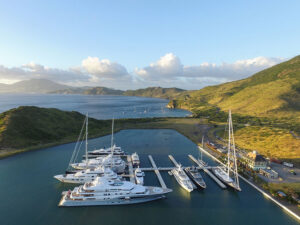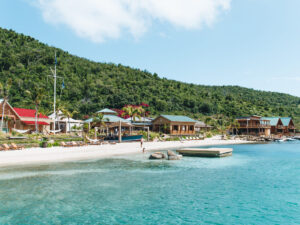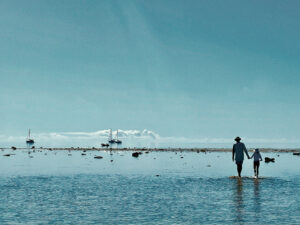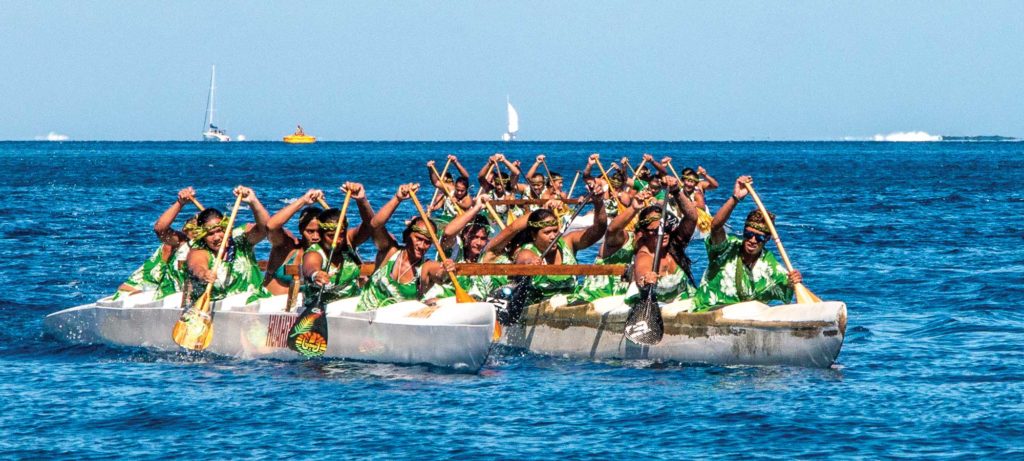
My wife, Carolyn, and I stood on the hill looking down on the picture-perfect Polynesian village of Haapu on Huahine, in French Polynesia. She’d forgotten her shoes aboard Ganesh, our 43-foot ketch. It was hot. The uphill climb on the grass path had been bad enough, but now the long down-sloping road consisted of sharp, hot lava rocks. We both glistened with sweat. There was no way we were going to manage this next part of our journey by swapping my pair of Crocs back and forth. The sun was bright, too bright, and beating down in waves.
“I think not,” I said, conceding defeat. We’d have to turn back.
“I agree,” she sighed. “What a shame. I’ve heard the village is lovely.”
Just then, a wobbly bicycle crested the hill. With a glance, the silent Polynesian lad riding it took it all in, kicked off his flip-flops, coasted downward and then patiently waited for us at the bottom of the hill.
He had not a word of English, yet it was a perfect example of the intelligence and politeness of the proud Polynesian. His small act of kindness was exactly why my family had set off for French Polynesia aboard the schooner Elizabeth in the mid-1950s, and why Carolyn and I keep returning to this day.
There are no islanders as gracious, generous, smarter, more artful or welcoming than the Polynesians. Life here is like a lusty Gauguin painting sprung to life.
Never heard of Huahine? Well, you should have been in London in 1774, when its favorite celebrity, Omai (a round-trip guest on James Cook’s Endeavor), charmed the whole town and became the first Polynesian to visit England. (Yes, he eventually retired back to Huahine. Lucky him!)
RELATED: The Spell of Maupiti
Of course, my job as a professional wordsmith is to paint you a vivid textual picture of the utopian reality of rural Polynesia. But I’m tempted to say that my dog-eared thesaurus doesn’t have enough adequately encompassing superlatives.
Picture living within a floating flower, adrift on a dazzling blue sea, with children laughing, fish jumping and God smiling.
That’s close, but still falls flat.
How can I describe the timeless charm of these carefree isles? How do I capture that lovesick heart-bursting feeling I have for these sacred islands where, as we returned to our vessel later that day, a sudden gust of wind blew fragrant flowers into the air, our hair, our dinghy, and sprinkled them generously into the sea ahead, as if our entire existence was a-swirl with the intoxication of the tiare flower?
How much does it cost to buy a boat, outfit it and sail here? Who the hell cares. Whatever it costs, it’s worth it.
Yes, I’m unabashedly drunk on Huahine! Smitten! Gobsmacked! After 58 years of living aboard, after all these glorious ports in my wake, Polynesian isles like Huahine still bring out the starry-eyed child in me, still put me in touch with the simple joy of being alive.
We stopped for a day, and stayed for a month. That’s what being a sea gypsy is all about: recognizing the butterfly of opportunity as it flits by. We first heard about the islandwide party on the dinghy dock of Fare, the island’s laid-back capital.
“What’s a Heiva festival?” asked Carolyn.
“I don’t know,” I responded, “but any fete is good for Fat!”
Heiva, it turns out, means “to gather” in the local lingo, and the entire month of July in the Society Islands is dedicated to celebrating their indigenous arts: singing, dancing, farming, cooking, canoeing, carving, drawing, sculpting, drumming, ukulele playing, plant grafting, coconut opening, rock carrying, flower-crown creating, storytelling and more.
The good vibes were so thick you could float an eight-man outrigger on them.
Why are Huahine and the Polynesians so special? One element is their pride; another, their desire to excel. They are also highly adaptable. We know of no other island culture that has changed as quickly, with such little fuss. Best of all, they haven’t forgotten their illustrious, adventurous past.
Remember, while Chris Columbus and his boys were attempting to get their cumbersome craft to sail into the wind at 3 knots through smooth seas, the local Polynesian lads were commuting and carrying cargo back and forth between Tahiti and Hawaii without a thought, swiftly and safely.
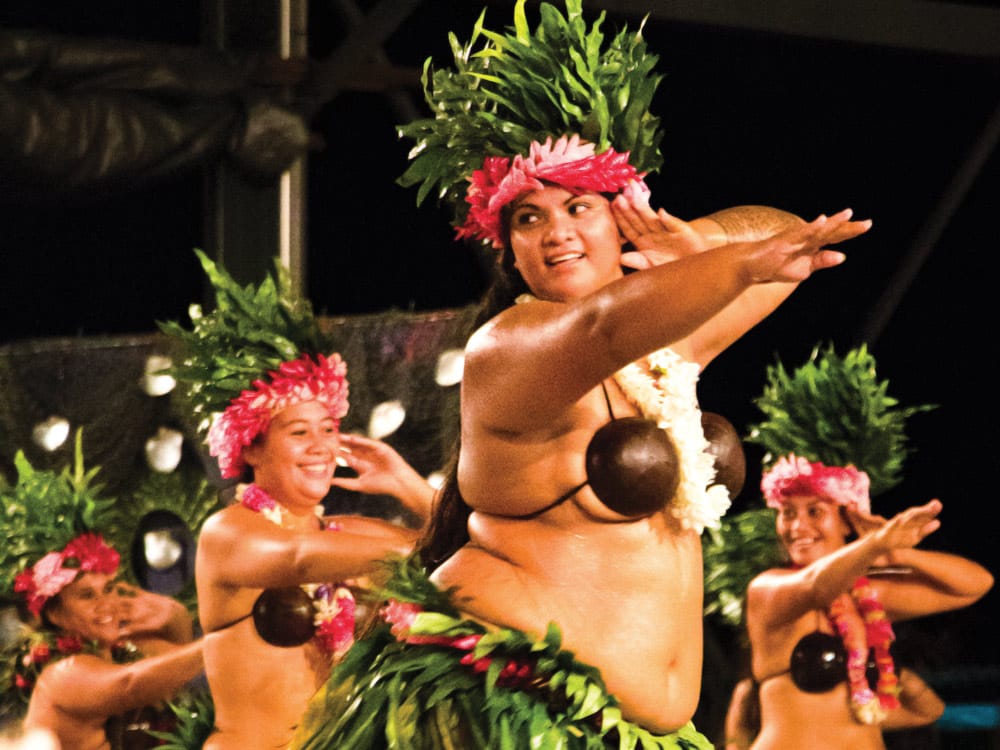
As regular readers of this publication know, I’ve spent many happy decades cruising the Lesser Antilles and the Caribbean. I love the West Indies: the people, their music, their laid-back culture. However, I would never row ashore in St.Thomas and ask a local to dance for me. They would be outraged. And I might end up dead. However, Polynesians in the Pacific are exactly the opposite. We’ve had villages send their chief out in a canoe to beg us to come ashore so the village could put on a show of dancing and singing — no charge, just for the fun of it.
Which brings us to the delicate subject of butt-shaking and religion.
Missionaries arrived in this area in the 1800s with Bibles. They also carried germs that killed off many of the locals. Yet Tongans, Fijians and Cook islanders had no problem accepting the Gospel and stopping their “obscene” dancing. Thus, to this day, the dancers of Hawaii use graceful arm movements to portray what was once done with wild hips.
I’m happy to say, the people of Huahine rejected the whole “don’t move your hips, you heathens!” concept, and faithfully maintain their traditional Polynesian dances, which leave little doubt as to how babies are made.
To say the woman and men of Huahine know how to shake their booties is a vast understatement, and some of their butts are glorious, majestic and ultrawide.
Think dancing and being sexy is for thin folk? Not in Huahine! Dancers here are rated by the ton; the more, the merrier.
But it is the gyrating butts that truly stun. Picture a 110-volt paint shaker plugged into 220 volts, and you’re close. It’s like watching mountains undulate.
In order to fully appreciate the diversity of the local performers, Carolyn and I rented a small motor scooter and toured the bi-fold-shaped island at a snail’s pace, stopping at every village and marae (sacred place) along the way to chat. Everyone welcomed us with open arms. We’d just wade into a group of fishermen and I’d ask them a question about their boats. We’d be instantly embraced as brothers of the sea.
Each village tries to outdo the others’ dancing during Heiva, with the winners eventually competing against each other in a cataclysmic, earthquake-inducing finale in Fare. Picture the Olympics with blurred, twirling, twisting butts and you’ll get the idea.
Don’t confuse these affairs with the staid tourist shows at the resorts. These pageants are staged by Polynesians, with Polynesians, for Polynesians. Carolyn and I were the only off-islanders at many of the exhibitions. (Who knew taro-and-bread-fruit carrying could be so sensuous and entertaining?)
Let’s take the night we watched the village of Parea perform, for example. Since we’d be coming home in the dark, we contracted with a local named Heipua Faahu for a taxi that cost $5 each, round-trip. Heipua was delighted that we were honoring his village by attending, and asked if he could bring his wife, Tatiana, along, because she wanted to see the show too.
Of course!
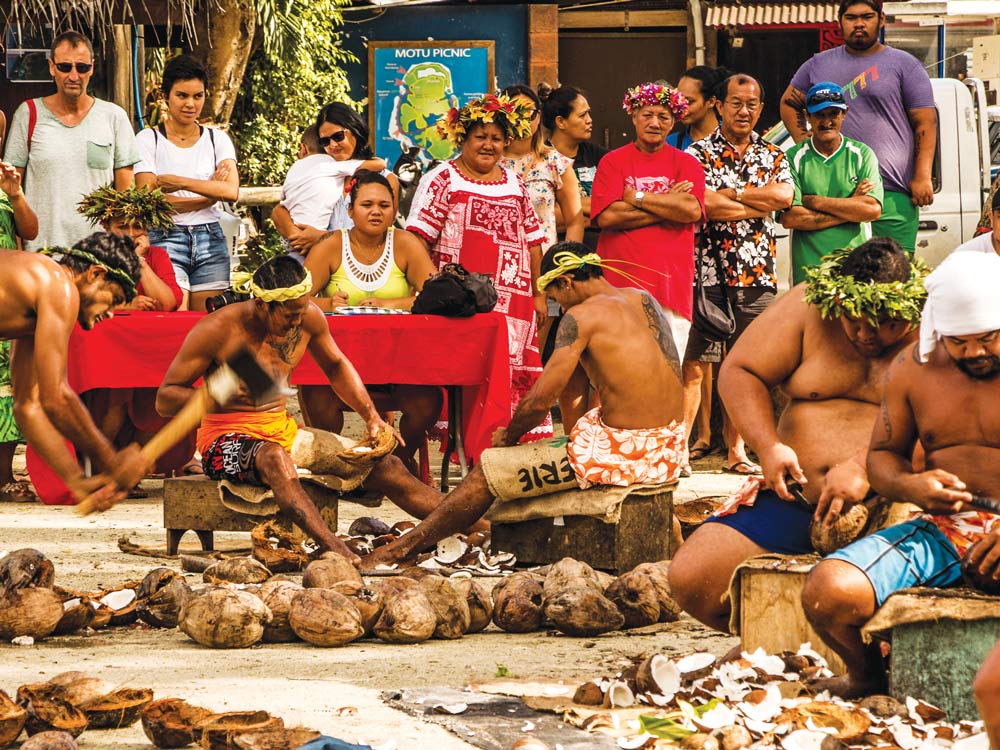
Tatiana turned out to be a delightful lady, fiercely proud of her culture, who gave us each a large floral arrangement of fragrant tiare flowers to wear around our necks, so that we, too, would “smell heaven” along with the performers. Only in Polynesia will a $5 taxi ride net you 40 or so fragrant fresh flowers and a kiss on both cheeks!
Now, I’ve seen some exotic floor shows in Paris, New York and Rome, but nothing as otherworldly and thrilling as these grass-skirted troopers. And the adoring audience included everyone in town, from the ancients to the just-born. All thrilled to witness the pageantry, the music, the dancing, the singing — the whole amazing ambience of one big family coming together with unabashed pleasure.
Carolyn’s favorite moment came at the climax of the wildflower-crown awards, when the chief of Fare placed the winning arrangement on an arranger’s head and their smile lit up the sky.
My favorite moment came during the dramatic, highly dangerous copra competition, during which they ax open a coconut and remove its meat. One of these teams, about 10 feet away from me, was covered in tattoos. I looked at their hands, and each finger was a mass of scars; ditto their feet. They openly prayed before the competition, beseeching the gods, both local and imported, to smile upon them. At the last possible minute, members of the team sharpened their axes and knives to perfection, finely stropping the surgical edges with leather toward the end. Immediately before the gun, they sort of swayed to limber up, eagerly a-quiver to begin.
Then, bang! Coconuts literally flew. Ax blades whirled; knife blades flashed; and the mountain of coconut meat grew. What totally freaked me out was that they were holding the coconuts in place with their naked toes — and slicing the coconuts in half with their heavy, sharp axes. It seemed like only an instant before the winners, my lads with the tattoos, had their giant burlap sack full of coconut meat.
“Sell the boat,” I joked with Carolyn that evening when we returned to Ganesh. “I want to stay forever!”
“You think?” she smiled.
“Absolutely,” I laughed. “Tear up the passports.”
Neither of us spoke for a while, then Carolyn chuckled. “It’s fun, Fatty, growing old with you.”
Ah, finally! That’s it in a nutshell.
Huahine is a small green speck on our big blue planet where such words seem perfectly natural, where it is impossible to believe the world isn’t brimming with friendship, respect and love.
After three months of socializing with old and new friends in French Polynesia, the Goodlanders are currently holed up alone, but together, in the landless atoll of Beveridge Reef.

